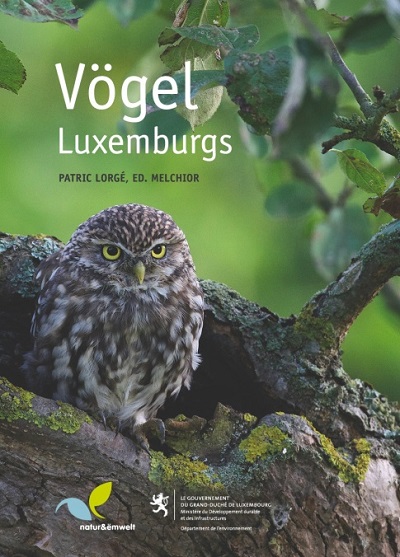
On Monday 30 March a press briefing was held by the Environment Ministry and Natur&Emwelt to launch the new edition of “Vögel Luxemburgs” (Birds of Luxembourg) by Patric Lorgé and Ed. Melchior; this is the second edition to contain photos, and the ninth since its first appearance in 1949.
Carole Dieschbourg, Luxembourg's Minister of the Environment, began by highlighting the six new “Natura 2000” protection areas recently designated by the Government. Biodiversity was in decline overall in Luxembourg as everywhere in Europe, and the endangered list is growing longer, but it was important not to paint too black a picture. More than a hundred species of bird breed in Luxembourg, and good news stories include the recovery of the Little Owl and the Black Stork, both of which have begun to breed again in the Grand Duchy after a long absence. To establish which species are threatened it is vital to have information, and this book helps make this information available to a wider public.
Patric Lorgé, one of the authors, explained that the book – with more than 400 photographs taken by volunteers – lists some 180 of the 310 wild bird species in Luxembourg, grouped according to their habitat: bodies of water; woodland; meadowland; arable land; former industrial sites; human settlements; orchards and parkland; and hedgerows.
Numbers of individuals or breeding pairs are given for each species, using figures taken from the Monitoring Programmes of Natur&Emwelt’s “Central Ornithologique” (2008-2012). Each entry shows what times of year the bird can be seen in Luxembourg, and its Red List status. For the first time, all bird names are given in Luxembourgish and English as well as in German, French and Latin.
There are also sections on migratory birds seen regularly in Luxembourg, and on rare (usually lost) visitors such as gulls. The book also contains a glossary, the 2015 Red List for Luxembourg, practical hints for helping birds in one’s own garden, and indexes of German and Latin species names. The book is printed in Luxembourg on recycled paper, to reduce its environmental footprint.
The Red List, which is updated every five years, records that two further species, the Whinchat and the Corn Bunting, are now extinct in Luxembourg. While some species have moved up a category, such as the Eagle Owl – a bird of good omen in Luxembourg thanks to its French name “Grand-Duc”! – the list also shows a number of cases of long-term decline such as the Meadow Pipit, the Skylark and the Lapwing.
Roby Biwer, President of Natur&Emwelt, said that the EU Wild Birds Directive (1979) and Habitats Directive (1982) provides a framework for national governments to protect wildlife in their own countries. However, this has not prevented a downward trend in biodiversity. Not just birds, but also butterflies, bees, and amphibians are threatened. This is largely due to habitat loss in agricultural areas, and farmers need to be encouraged to use methods which do the minimum damage to wildlife habitats. Unfortunately, under the cloak of the EU’s new Refit programme for eliminating red tape, some member states are seeking to water down the existing environmental legislation in the interest of saving money, which can only be bad news for wildlife.
Minister Dieschbourg pointed out that the financial benefits of environmental legislation far outweigh the costs, and said that financial help can be given to farmers to take environmental measures.
On the subject of habitat loss, Ed Melchior, the book’s other author, gave the specific example of the Partridge, which is now endangered in Luxembourg owing to changes in agricultural practice, and pointed out that it is extremely common in parts of East Germany where organic vegetables are grown. He also stressed the importance of ornithology as an entry into environmental protection as a whole. Some 85% of naturalists started out as bird watchers!
“Vögel Luxemburgs” is available from Natur&Emwelt and in most bookshops for €20.
By Henry Wickens (below, L-R): The Black Stork (making a comeback); The Whinchat (no longer with us)








